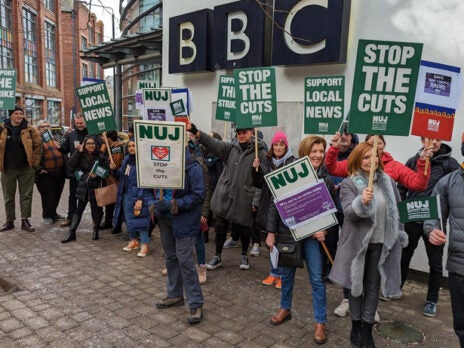
-
Circulation of daily-to-weekly titles down 22.8 per cent from launch
-
Relaunced weeklies down 14 per cent year on year in August
-
Insiders say figures are 'disastrous'
-
Highfield: Relaunch will return Johnston to growth
-
'Minority' of JP staff are opposed to change, says chief exec
Johnston Press chief executive Ashley Highfield has defended the company’s relaunch strategy despite new figures revealing significant circulation declines on most of its new-look titles.
Figures obtained from insiders at the Edinburgh-based publisher show sales of the five daily papers it switched to weeklies in May have fallen on average by 22.8 per cent from launch compared with the week of 25 August.
They also reveal that during the same week 11 of the relaunched weeklies averaged year-on-year circulation declines of 14 per cent.
Speaking to Press Gazette, Highfield said the sales slump was no cause for alarm and that circulation revenue had increased thanks to cover price rises of up to 25 per cent.
“Of course the circulation is down on the first launch week, that’s what everyone expects to happen,” he said.
“The main point is, is the circulation still better than where it would have been had we not relaunched? That’s the important test. Is the portfolio of papers in a better position than our non-relaunched papers? They are.
“And the second point, which is a really significant point, is that because we put the cover prices up, are we making more money from our papers now than we were before?
“In every case we’re making more advertising revenue because the advertisers like the new-look papers, and we’re making more circulation revenue because we have taken the decision to put cover prices up substantially, understanding that that would have some impact on circulation.”
While August is a notoriously slow month for sales, some insiders at the company were alarmed at the extent of the decline. An insider said the figures were “disastrous”, adding: “These relaunches were supposed to see a bump and then hold steady for a bit, not go into double figure percentage dips within six months.”
'Minority criticism'
Highfield also acknowledged criticism from within his company over its controversial relaunch strategy – admitting there will always be a “small minority” opposed to change at the newspaper group.
The Johnston Press chief executive spoke to Press Gazette after we obtained new figures revealing circulation declines on titles relaunched in May.
The fourth and final phase of Johnston’s plan to relaunch its 170-strong portfolio should have been completed in November, but Highfield announced this week that the second phase has now been postponed until January 2013 at the earliest.
Figures show that ten of the new-look weekly papers averaged year-on-year circulation declines of 14 per cent during the week ending 25 August.
Only the West Sussex County Times was able to avoid a double-digit drop, reporting a fall of 9.1 per cent to 15,115.
The worst-performing relaunch was the Ilkeston Advertiser, which saw its year-on-year sales slump 20.1 per cent to 5,776, followed by the Belper News, down 20 per cent year on year to 2,030.
One source at the company claimed that “readers openly ridicule the new designs and JP editors and journalists hate them”.
And a senior editorial figure reportedly told a recent meeting assessing the impact of the relaunches: “Whatever we’re doing, it’s not working.”
Commenting on the criticisms, Highfield said: “The vast majority of the feedback that I’m getting is that people are excited about this and up for it.
“There will always be some people, perhaps in more traditional markets, who are unhappy with the way the paper is.
“The problem is our advertisers are increasingly less happy with the papers and we’re not bringing in new audiences.
“We do need to move forward, but certainly if one asks around there will always be a minority of our own staff who’d rather we didn’t change the papers.”
He added: “We know there will always be a percentage of people who would rather we didn’t do this. It doesn’t mean it’s not the right thing to do.”
'In print we will end up with smaller circulation papers'
Sales of the five daily-weekly conversions fell 22.8 per cent on average from launch week compared with the week of 25 August.
The Northamptonshire Telegraph suffered the worst drop – during its launch week it sold 29,681 copies but during the week of 25 August this figure had fallen 33.5 per cent to 19,727.
Sister title the Peterborough Telegraph fell 29.1 per cent to 16,325 during the same period, the Northampton Chronicle & Echo fell 22.3 per cent to 20,785 and the Halifax Courier was down 19.9 per cent to 19,136.
The only weekly conversion that did not suffer double-digit losses over the three months was the Halifax Courier, which fell 19.9 per cent to 23,901.
Highfield said the figures were not unexpected, adding that “circulation revenues and sales revenues are better than we expected”.
“It’s a largely irrelevant week [relaunch week] because that’s the week we had all the marketing activity and we had people walking the streets handing the papers out,” he said.
“I think that you’ve got to take it from the week prior to that, and then you’re starting to look at the better indication of the performance.”
According to this measure, circulation of the weeklies compared with the average daily sale is up 41.6 per cent on the pre-relaunch week. The Scarborough News, for example, sold 16,154 copies a week in the week of 25 August, up 74.5 per cent on its average daily sales of 9,256 in the week before relaunch.
Commenting on the performance of the weeklies, Highfield said: “In some cases the actual circulation numbers aren’t as good as we hoped, in some cases they’re better than we hoped,” he said.
“But that was why we chose 23 titles for phase one and tried something different with every one of them. We don’t know all the answers and so what we want to do is to learn from phase one.
“As it happens of course we launched phase one into the rather bizarre dynamics of the Jubilee, the strange weather and the Olympics. But I don’t think we’ve learnt quite as much as we’d wanted to.
“If you take one paper, our West Sussex County Times, two weeks ago it was showing double-digit decline, which was what we expected because we really whacked the cover price up on that.
“Last week we’ve come back after the holidays and it’s showing only minus five. Now at minus five that means that it’s actually improved on its rate of decline before we relaunched it, and we’ve put the cover price up by 25 per cent.”
Some of the lessons learned from the new titles, according to Highfield, include increasing pagination at some titles, including more business news, and a greater focus on “ultra-local news”.
He added: “The really important thing is, is the relaunch going to help Johnston Press stay not just in business but get back to growth? Yes it is, because we’re going to make more circulation revenue and advertising revenue from the papers.
“The trick is to do that with the absolute minimum circulation decline, and therefore we want to make sure that all the relaunch papers trend better than they were trending before we launched them. I think that’s the acid test.
“I think that, ultimately, in print we will end up with smaller circulation papers, but hopefully actually earning us more because people are prepared to pay more for them, and obviously the growth will largely come from digital.”
Email pged@pressgazette.co.uk to point out mistakes, provide story tips or send in a letter for publication on our "Letters Page" blog







